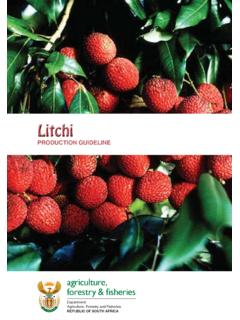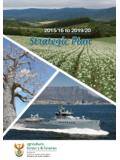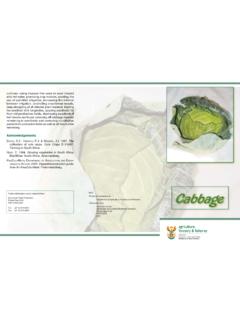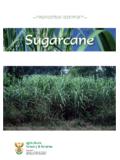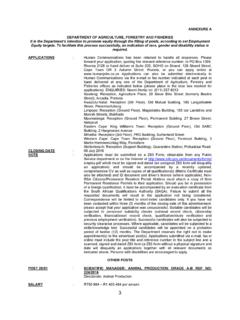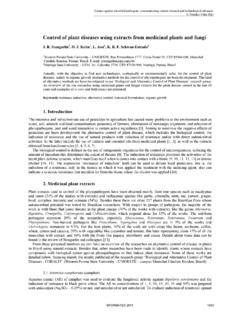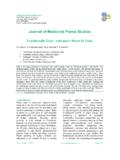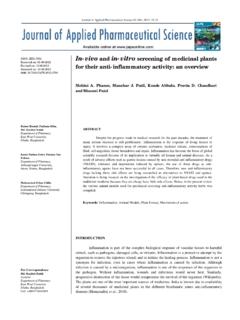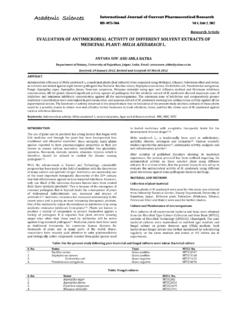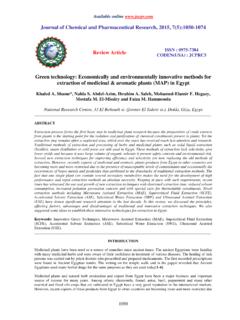Transcription of Medicinal plants
1 Medicinal plants of South Africa Directorate: Plant Production agriculture, forestry & fisheries Department: Agriculture, Forestry and Fisheries REPUBLIC OF SOUTH AFRICA. Medicinal plants of South Africa 2013. Compiled by Directorate: Plant Production 2013 Content Compiled by Directorate Plant Production 1. Aloe ferox .. 1. Design and layout by 2. African 2. Directorate Communication Services 3. Wild 3. 4. Cancer 4. 5. Devil's 5. 6. African 6. 7. Hoodia 7. 8. 8. 9. 9. 10. Wild 10. 11. African 11. For further information please contact 12.
2 Pepperback 12. Directorate: Plant Production 13. Pineapple 13. Private Bag X250. 14. Pelargonium 14. PRETORIA 0001. Tel.: +27 12 319 6072 15. 15. Fax: +27 12 319 6372 16. 16. E-mail: 17. Organisation 17. 18. 17. Introduction 1. Aloe ferox Medicinal plants are plants which are used in herbalism and thought to have certain Scientific name: Aloe ferox Mill extractable/compound in their leaves, stems, flowers and fruit for Medicinal purposes. Common names: Bitter aloe, tap aloe, cape aloe, red aloe (English); bitteraalwyn, These extracts are used as inputs in the pharmaceutical, nutraceutical, insecticide tapaalwyn, bergaalwyn (Afrikaans); inlaba (isiZulu); ikhala and other chemical industries.
3 The booklet is a guide to the most commonly utilised Medicinal plants in South Africa. (isiXhosa). Family: Aloaceae Description: Aloe ferox is a succulent plant that reaches 2 to 3 m in height. It has a perennial, strong and adventitious/fibrous root system and is a robust, single, unbranched woody stemmed plant. The leaves are broad, dull green to greyish green, but turn reddish in colour when under drought stress. Production areas: In South Africa, Aloe ferox is distributed throughout the Western Cape, Eastern Cape, southern KwaZulu-Natal, south-eastern part of the Free State.
4 Parts used: Leaves Climatic and soil requirements: Aloe ferox grows well in warm climates with a temperature ranging between 12 oC and 21 oC. The plant also grows well on a well drained, sandy soil. Propagation: It may be grown from seeds and stem cuttings. Seeds can be collected in winter or spring. Planting: It can be planted in spring, 1,5 to 2 m from each other. Fertilisation: A small quantity of manure is required to enhance the growth of the plant and organic compost to speed up growth. Pests: The major insects identified in Aloe ferox include aloe snout beetle, scale insects, mealy bug and mites.
5 Diseases: The plant is prone to a variety of diseases, including aloe cancer (also called galls), leaf spots, bacterial infections and aloe rust. Harvesting: The crop is ready for harvesting after 18 months of cultivation. Only 10. to 15 of the lower leaves of an adult plant are harvested once a year. The leaves are cut with a sickle. Uses: Leaves have been traditionally used for stomach complaints, arthritis, eczema, conjunctivitis, hypertension and stress. They are also used to treat skin irritations and bruises.
6 Vi 1. 2. African ginger 3. Wild rosemary Siphonochilus aethiopicus Scientific name: Scientific name: Eriocephalus africanus Common names: Natal ginger, african ginger (English); wildegemmer (Afrikaans); Common names: Wild rosemary, marsh rosemary, moorwort, cape snowbush indungulo, isiphephetho (isiZulu) (English); pokbos (Afrikaans). Family: Zingiberaceae Family: Labiatae Description: African ginger is a herbaceous perennial plant of the forest floor. The flowers are broadly funnel- shaped, pink and white in colour.
7 The leaves are light Description: The plant is a small, multi-branched evergreen shrub of up to 1 to green, heart- shaped and borne on the end of stem-like leaf bases. The stems reach 1,5 m in height. It has woody stems with brown, tough bark. The root system is well- a maximum height of 2 m. It has thick roots, whitish or buff- coloured in appearance. developed with a taproot that can penetrate the soil to a depth of 6 m and lateral roots that extend about 2 m around the plant. The evergreen leaves are about 2, Production areas: In South Africa, African ginger is distributed in Mpumalanga and 54 cm long.
8 Limpopo. Parts used: Secondary roots and rhizomes Production areas: In South Africa, wild rosemary is distributed throughout the Western Cape and Eastern Cape Province. Climatic and soil requirements: A soil temperature of between 20 and 22 oC and air temperature of around 20 oC are suitable. It grows best in a well-drained, red and Parts used: The young tops, leaves, flowers, seed and stems/sprigs yellowish-brown soil rich in organic matter. The best soil pH for african ginger is 6,0. Climate and soil requirements: Wild rosemary prefers night temperatures of to 7,0.
9 Between 10 to 13 oC, day temperatures of between 20 and 22 oC and well-drained Propagation: African ginger is propagated by seeds, rhizomes or tissue culture. soil that is sandy, loamy and quite dry. Propagation of rhizomes can be done in spring. Propagation: Wild rosemary is propagated by seeds, cuttings, layering and division Planting: Spring or summer is the ideal time for planting african ginger. Seeds should of roots. be planted in 2 or 3 furrows, approximately 15 cm deep into the soil with a spacing of 18 cm apart and 72 cm between the rows.
10 Planting: The seeds can be sown in spring or autumn and the cuttings can also be taken in spring or autumn, however, in the Western Cape it is planted in the wet Fertilisation: High levels of organic matter are required. Light application of organic winter months. Cultivated plants are planted in rows and spaced 1, 2 m x 0, 5 m fertiliser ( N, P and K) should be made. apart. Pests: The major insects and pest identified in african ginger include nematodes, aphids, caterpillars, leaf-miner, leaf spots and mites. Fertilisation: Nitrogen, phosphorus, potassium and sulphur should be applied annually according to the soil analysis.

